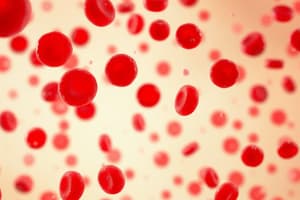Podcast
Questions and Answers
Which of the following best describes the primary role of erythrocytes?
Which of the following best describes the primary role of erythrocytes?
- Phagocytizing bacteria and cellular debris.
- Defending the body against parasitic infections.
- Transporting oxygen via hemoglobin. (correct)
- Facilitating blood clotting through aggregation.
A patient is diagnosed with leukopenia. What does this condition indicate?
A patient is diagnosed with leukopenia. What does this condition indicate?
- An elevated white blood cell count, potentially indicating infection.
- An excessive number of platelets, increasing the risk of thrombosis.
- A deficiency in red blood cells, leading to reduced oxygen transport.
- A decreased number of white blood cells, possibly impairing immune function. (correct)
Which sequence of events correctly describes the process of hemostasis following a blood vessel injury?
Which sequence of events correctly describes the process of hemostasis following a blood vessel injury?
- Fibrin formation → vasoconstriction → platelet adhesion.
- Vasodilation → platelet plug formation → fibrinolysis.
- Vasoconstriction → platelet plug formation → blood coagulation. (correct)
- Platelet aggregation → vasodilation → coagulation cascade.
During an infection, which type of leukocyte would you expect to see an elevated count of in a patient's blood sample?
During an infection, which type of leukocyte would you expect to see an elevated count of in a patient's blood sample?
What is the role of thrombopoietin in hematopoiesis?
What is the role of thrombopoietin in hematopoiesis?
Which of the following characteristics distinguishes granulocytes from agranulocytes?
Which of the following characteristics distinguishes granulocytes from agranulocytes?
What is the primary function of the spleen in relation to red blood cells?
What is the primary function of the spleen in relation to red blood cells?
A patient with an autoimmune disorder is experiencing excessive bleeding due to impaired blood clot formation. Which component of blood is most likely affected?
A patient with an autoimmune disorder is experiencing excessive bleeding due to impaired blood clot formation. Which component of blood is most likely affected?
Why is compatibility crucial in blood transfusions?
Why is compatibility crucial in blood transfusions?
In diagnosing hematological disorders, what information does a Complete Blood Count (CBC) primarily provide?
In diagnosing hematological disorders, what information does a Complete Blood Count (CBC) primarily provide?
Which type of anemia is characterized by microcytic and hypochromic red blood cells?
Which type of anemia is characterized by microcytic and hypochromic red blood cells?
What is the underlying cause of macrocytic anemia in Vitamin B12 deficiency?
What is the underlying cause of macrocytic anemia in Vitamin B12 deficiency?
What is pancytopenia, a characteristic feature of aplastic anemia?
What is pancytopenia, a characteristic feature of aplastic anemia?
In sickle cell anemia, what is the primary mechanism that leads to pain and organ damage?
In sickle cell anemia, what is the primary mechanism that leads to pain and organ damage?
What is the Philadelphia chromosome associated with?
What is the Philadelphia chromosome associated with?
What is the hallmark characteristic used to distinguish Hodgkin Lymphoma from Non-Hodgkin Lymphoma?
What is the hallmark characteristic used to distinguish Hodgkin Lymphoma from Non-Hodgkin Lymphoma?
In the context of Myeloproliferative Neoplasms (MPNs), what condition is characterized by the overproduction of red blood cells?
In the context of Myeloproliferative Neoplasms (MPNs), what condition is characterized by the overproduction of red blood cells?
What is the primary defect in Von Willebrand Disease?
What is the primary defect in Von Willebrand Disease?
Flashcards
Hematology
Hematology
The study of blood, blood-forming organs, and blood disorders.
Blood Plasma
Blood Plasma
Liquid component of blood, containing water, proteins, electrolytes, and clotting factors.
Erythrocytes
Erythrocytes
Blood cells responsible for oxygen transport via hemoglobin.
Erythropoiesis
Erythropoiesis
Signup and view all the flashcards
Hemoglobin
Hemoglobin
Signup and view all the flashcards
Leukocytes
Leukocytes
Signup and view all the flashcards
Thrombocytes
Thrombocytes
Signup and view all the flashcards
Hematopoiesis
Hematopoiesis
Signup and view all the flashcards
Fibrin
Fibrin
Signup and view all the flashcards
Blood Groups
Blood Groups
Signup and view all the flashcards
Anemia
Anemia
Signup and view all the flashcards
Iron Deficiency Anemia
Iron Deficiency Anemia
Signup and view all the flashcards
Vitamin B12 Deficiency (Pernicious Anemia)
Vitamin B12 Deficiency (Pernicious Anemia)
Signup and view all the flashcards
Aplastic Anemia
Aplastic Anemia
Signup and view all the flashcards
Hemolytic Anemia
Hemolytic Anemia
Signup and view all the flashcards
Sickle Cell Anemia
Sickle Cell Anemia
Signup and view all the flashcards
Leukemia
Leukemia
Signup and view all the flashcards
Lymphoma
Lymphoma
Signup and view all the flashcards
Study Notes
- Hematology is the study of blood, blood-forming organs, and blood disorders.
- It encompasses the physiology, pathology, etiology, and treatment of these disorders.
Components of Blood
- Blood consists of plasma and formed elements (cells).
- Plasma is the liquid component, comprising water, proteins, electrolytes, clotting factors, and other substances.
- Formed elements include red blood cells (erythrocytes), white blood cells (leukocytes), and platelets (thrombocytes).
Red Blood Cells (Erythrocytes)
- Erythrocytes are responsible for oxygen transport.
- They contain hemoglobin, an iron-containing protein that binds to oxygen.
- Erythropoiesis is the process of red blood cell production, stimulated by erythropoietin (EPO) from the kidneys.
- Red blood cells are anucleated and biconcave-shaped.
- The lifespan of a red blood cell is approximately 120 days.
- Old or damaged RBCs are removed by the spleen.
- Anemia is a deficiency in red blood cells or hemoglobin.
- Polycythemia is an excess of red blood cells.
White Blood Cells (Leukocytes)
- Leukocytes are involved in immune defense.
- They are classified into granulocytes (neutrophils, eosinophils, basophils) and agranulocytes (lymphocytes, monocytes).
- Neutrophils are the most abundant type of WBC and are crucial for phagocytosis of bacteria.
- Eosinophils defend against parasites and are involved in allergic reactions.
- Basophils release histamine and heparin, contributing to inflammation.
- Lymphocytes include T cells (cellular immunity), B cells (humoral immunity), and NK cells.
- Monocytes differentiate into macrophages, which phagocytize pathogens and cellular debris.
- Leukocytosis is an increase in the number of white blood cells.
- Leukopenia is a decrease in the number of white blood cells.
Platelets (Thrombocytes)
- Thrombocytes are involved in blood clotting (hemostasis).
- They are fragments of megakaryocytes.
- Platelets adhere to damaged blood vessel walls and aggregate to form a platelet plug.
- Thrombopoietin regulates platelet production.
- Thrombocytopenia is a deficiency in platelets.
- Thrombocytosis is an excess of platelets.
Hematopoiesis
- Hematopoiesis is the formation of blood cells, primarily in the bone marrow.
- All blood cells arise from hematopoietic stem cells.
- Cytokines and growth factors regulate hematopoiesis.
Hemostasis
- Hemostasis is the process of stopping bleeding.
- It involves vasoconstriction, platelet plug formation, and blood coagulation.
- The coagulation cascade involves a series of clotting factors that activate each other, leading to fibrin formation.
- Fibrin stabilizes the platelet plug, forming a blood clot.
- Anticoagulants prevent excessive clotting.
Blood Groups
- Blood groups are determined by the presence or absence of specific antigens on red blood cells.
- The ABO blood group system includes four main types: A, B, AB, and O.
- The Rh blood group system is another important system, with Rh-positive and Rh-negative individuals.
- Blood transfusions must be compatible to avoid transfusion reactions.
Common Hematological Tests
- Complete Blood Count (CBC): provides information about the number and characteristics of blood cells.
- Peripheral Blood Smear: examination of blood cells under a microscope to assess morphology.
- Bone Marrow Aspiration and Biopsy: used to evaluate bone marrow function and diagnose hematological disorders.
- Coagulation Tests: assess the ability of blood to clot (e.g., PT, PTT, INR).
- Flow Cytometry: identifies and counts specific cell types based on surface markers.
Hematological Disorders - Anemia
- Anemia is a condition characterized by a deficiency of red blood cells or hemoglobin, resulting in reduced oxygen-carrying capacity of the blood.
Iron Deficiency Anemia
- Caused by insufficient iron to produce hemoglobin.
- Common causes include inadequate iron intake, blood loss, and malabsorption.
- Characterized by microcytic (small) and hypochromic (pale) red blood cells.
Vitamin B12 Deficiency (Pernicious Anemia)
- Caused by impaired absorption of vitamin B12, often due to lack of intrinsic factor.
- Results in macrocytic (large) and normochromic red blood cells.
Folate Deficiency Anemia
- Caused by insufficient folate intake or absorption.
- Also results in macrocytic anemia.
Aplastic Anemia
- Bone marrow failure leading to pancytopenia (deficiency of all blood cell types).
- Can be caused by drugs, toxins, infections, or autoimmune disorders.
Hemolytic Anemia
- Premature destruction of red blood cells.
- Can be caused by genetic defects, autoimmune disorders, or infections.
Sickle Cell Anemia
- A genetic disorder characterized by abnormal hemoglobin that causes red blood cells to become sickle-shaped.
- Sickle cells can block blood vessels, leading to pain and organ damage.
Thalassemia
- A group of genetic disorders characterized by reduced or absent production of globin chains.
- Results in microcytic and hypochromic anemia.
Hematological Disorders - Leukemia
- Leukemia is a group of cancers that affect the blood and bone marrow.
- Characterized by abnormal proliferation of white blood cells.
Acute Lymphoblastic Leukemia (ALL)
- Affects lymphocytes and progresses rapidly.
- Most common in children.
Acute Myeloid Leukemia (AML)
- Affects myeloid cells and progresses rapidly.
- More common in adults.
Chronic Lymphocytic Leukemia (CLL)
- Affects lymphocytes and progresses slowly.
- Most common leukemia in adults.
Chronic Myeloid Leukemia (CML)
- Affects myeloid cells and progresses slowly.
- Associated with the Philadelphia chromosome.
Hematological Disorders - Lymphoma
- Lymphoma is a cancer that affects the lymphatic system.
- Characterized by abnormal proliferation of lymphocytes.
Hodgkin Lymphoma
- Characterized by the presence of Reed-Sternberg cells.
- Often starts in a single lymph node and spreads in an orderly fashion.
Non-Hodgkin Lymphoma
- A diverse group of lymphomas that do not have Reed-Sternberg cells.
- Can arise in any lymph node or organ.
Hematological Disorders - Myeloproliferative Neoplasms (MPNs)
- MPNs are a group of disorders characterized by overproduction of one or more blood cell types in the bone marrow.
Polycythemia Vera (PV)
- Increased production of red blood cells.
Essential Thrombocythemia (ET)
- Increased production of platelets.
Primary Myelofibrosis (PMF)
- Replacement of bone marrow with fibrous tissue.
Hematological Disorders - Bleeding Disorders
Hemophilia
- Inherited bleeding disorder caused by deficiency of clotting factors (e.g., factor VIII in hemophilia A, factor IX in hemophilia B).
Von Willebrand Disease
- Most common inherited bleeding disorder, caused by deficiency or dysfunction of von Willebrand factor (vWF).
Disseminated Intravascular Coagulation (DIC)
- A life-threatening condition characterized by widespread activation of the coagulation system, leading to thrombosis and bleeding.
Thrombotic Thrombocytopenic Purpura (TTP)
- A rare blood disorder characterized by formation of blood clots in small blood vessels throughout the body.
Studying That Suits You
Use AI to generate personalized quizzes and flashcards to suit your learning preferences.




